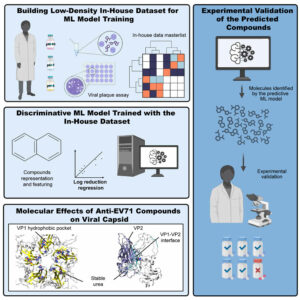 Introduction
Introduction
Artificial intelligence algorithms have now been combined with traditional laboratory methods to uncover promising drug leads against human enterovirus 71 (EV71), the pathogen behind most cases of hand, foot and mouth disease. The study published in Cell Reports Physical Science showed that reliable antiviral predictions can be made even when only a modest amount of experimental data are available.
AI streamlines the research process
Using an initial panel of 36 small molecules, the researchers team trained a machine learning model to spot certain shapes and chemical features that help stop viruses, scoring each compound’s likelihood of blocking EV71. The authors put their AI-chosen shortlist to the test: out of eight compounds, five successfully slowed the virus in cell experiments—about ten times more hits than traditional screening methods usually deliver.
EV71 infections can escalate from mild rash and fever to severe neurological complications, particularly in children under seven and immunocompromised adults. No FDA-approved antivirals currently target the virus.
All five confirmed results were tested using computer simulations, which showed that they stuck to certain spots on the virus, findings which could help future researchers stop the virus from changing shape and entering cells.
Conclusion
This study can be seen as a template for rapid antiviral discovery. Whether the next threat is another enterovirus, an emergent respiratory pathogen or a reemerging virus like polio, the AI-driven method shows that, even with limited data, machine learning can accelerate the development of effective solutions and drive a swift response to future outbreaks.
The work included collaboration with Procter & Gamble and Cornell University. Research reported in this publication was supported by the Langer Prize (AIChE Foundation), the NIH R35GM138201, DTRA HDTRA1-21-1-0014, and NIAID NIH R01AI149487.
For more information on this study, please refer to the full paper published in Thrends in Biotechnology: https://www.cell.com/cell-reports-physical-science/fulltext/S2666-3864(25)00153-5
For more information, please contact:
Machine Biology Group
University of Pennsylvania
Authors:
Angela Cesaro, Fangping Wan, Haoyuan Shi, Kaiyang Wang, C. Mark Maupin, Matt L. Barker, Jiqian Liu, Stephen J. Fox, Jingjie Yeo, Cesar de la Fuente-Nunez.
Published:
April 29, 2025
About Machine Biology Group:
The mission statement of the Machine Biology Group at the University of Pennsylvania is to use the power of machines to accelerate discoveries in biology and medicine.
